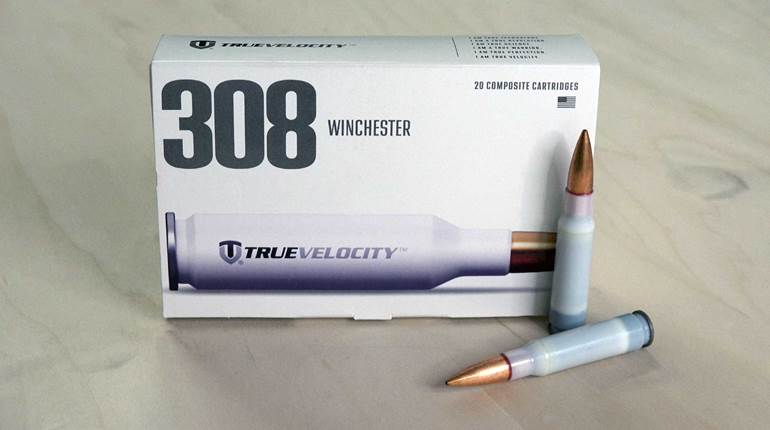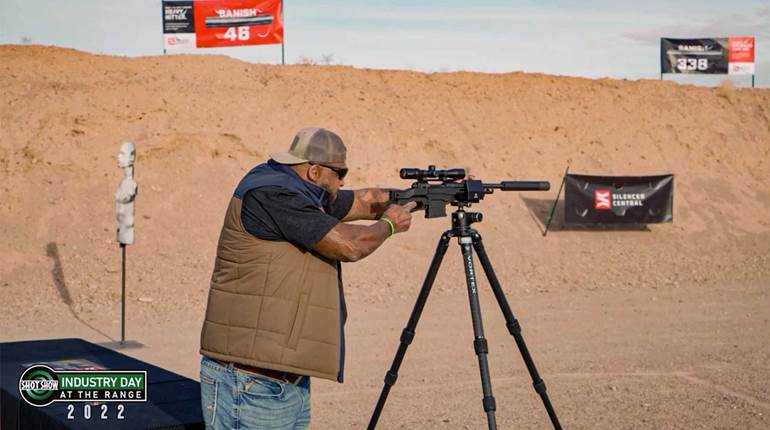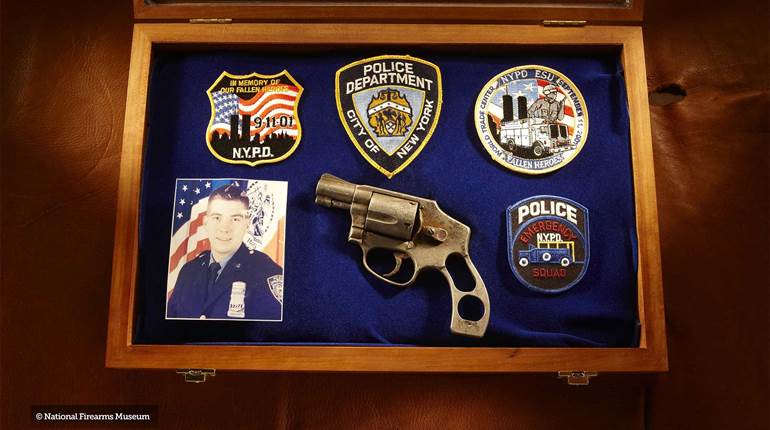
The “Tommy Gun” is one of the most iconic firearms in American history. But what is it about the Thompson? Stephen Hunter, a bestselling novelist and Pulitzer Prize-winning writer for, of all things, the Washington Post, is a pretty serious and savvy gun guy, and he summed up much of the Thompson’s appeal in a March 22, 2004, article on the Exhibit at the National Firearms Museum.
He wrote: “They invented a classic. The gun they came up with in its final form was reliable accurate, light enough, relatively easy to manufacture, powerful. And it was one other thing, almost accidentally, it was beautiful. As a consequence the Thompson, like a few other guns, a few automobiles, a few paintings, a few symphonic bars, a few first paragraphs, became a phenomenon that transcended its design and utility. It was an example of what might be called charismatic harmony, choreography of slopes and flats and angles as executed in brilliantly machined steel.”
Oddly enough, for such an iconic and indeed legendary design, it had a very shaky start. And much of that had to do with timing. When General John Thompson examined the functioning prototype in .45 ACP—a cartridge he and Col. LaGarde played a significant role in developing—Thompson envisioned it as a man-portable “trench broom’ putting an incredible amount of firepower into one man’s hands and, literally, sweeping the trenches of World War I of enemy combatants.
The Thompson, if not a war winner could have been a fight winner, and fights win battles and battles win wars. But it was not to be, as by the time the Thompson was ready, the urgent need for its creation ended with the Armistice of Nov. 11, 1918. As one Belgian officer stated in 1923, “If we had had Thompson guns in 1914, the Germans could never have taken Belgium.” A bit optimistic perhaps, but they sure could have slowed them down a little more.
With the war over and no urgent military demand, the U.S. Ordnance Department promptly put its head back in the sand, or up a piece of human anatomy that cannot be mentioned in a family presentation such as this. The world was decimated and bankrupted, and there was no urgent need for a new type and design of arm—no matter how good. And the Thompson was good indeed. But big military orders were not forthcoming. Thus began the civilian side of the legend, good and bad.
It became, as aptly put in the title of William G. Helmer’s book, The Gun That Made The 20s Roar. With no military contracts, the Thompson was marketed to law enforcement and civilians. My favorite ad of all time—period—features an image of a cowboy, complete with bandana and big furry chaps, mowing down marauding banditos with the description, “The ideal weapon for the protection of estates, ranches plantations, etc.” I’ll go along with that.
It’s potential as a law enforcement tool was recognized in a 1920 issue of Scientific American: “Without doubt the early future will see the happy coincidence of a policeman skilled in the pointing of the new weapon, and an automobile full of yeggs willing to engage in the customary running gun fight. The result will be the worst shot up assortment of crooks that that has ever come to the attention of the coroner.”
Just so you know, “yegg” is a contemporary term for a safecracker or robber. I had to look it up, too. It appears several times, by the way, in the dialogue of the movie “Miller’s Crossing,” I didn’t make it up.
The Thompson was, as the company’s slogan put it, “on the side of law and order.” For flying squads, Revenuers and G-men like J. Edgar Hoover, Melvin Purvis and Elliott Ness (whether the man or TV character), it was the ultimate crime fighting tool.
But the criminal element, the yeggs, soon saw the virtues of the Thompson, too “That’s the gun! It’s got it over a sawed off shotgun like the shotgun has it over the automatic.” That quote is attributed to Al Capone. Gangsters and outlaws, such as Machine Gun Kelley, John Dillinger, Clyde Barrow and Baby Face Nelson, just to name a few, were fans of the Tommy gun, much to the horror of the genteel patriotic General Thompson.
And perhaps even more significant was the employment by big screen bad guys and heroes. Until World War II, Hollywood Thompsons likely gunned down more bad guys than the real deal.
While most of the U.S. military didn’t show much interest in the Thompson, the Navy accepted it for the Marine Corps in 1928, and the Army finally adopted the M1928A1 in 1940. But the gun’s firepower and utility were immediately recognized by, of all people, the Irish. Model of 1921s figured prominently in the hands of Irish patriots—or terrorists depending on one’s perspective—during the “troubles” and the Irish Civil War, often in the hands of pro-treaty men and the Free State Army, perhaps more so than the IRA. And the Tommy gun has been made legend in the song and story of the struggle for Irish independence and national identity. As one contemporary song put it:
“We’re off to Dublin in the green, in the green,
“Where helmets glisten in the sun,
“Where the bayonets flash and the rifles crash,
“To the echo of the Thompson Gun.”
As an interesting side note, one of the many things the Thompson has been is a labor relations tool. The quip “You can’t run a mining company without a few Tommy guns” has been attributed to a prominent American industrial magnate, and it reflects the ability of concentrated firepower to subjugate the masses. Even today some states don’t allow civilian ownership of machine guns as vestige of class warfare from a bygone era.
A member of the British general staff said of the Thompson that the British army wasn’t interested in “gangster weapons.” But Hitler’s legions rampaging through Poland, France and most of the rest of Europe soon corrected that parochial view. After the debacle that was the fall of France and the miracle of Dunkirk, the British Purchasing commission in the United States made Thompsons second in priority only to aircraft for shipment to the beleaguered island nation, which stood alone against the might of Hitler’s war machine.
Indeed, it is the image of Winston Churchill, defiantly brandishing both cigar and Thompson that gives extra punch to the defiant words:” We shall go on to the end … we shall fight on the beaches, we shall fight on the landing grounds, we shall fight in the fields and in the streets, we shall fight in the hills; we shall never surrender … until, in God's good time, the New World, with all its power and might, steps forth to the rescue and the liberation of the old."
Part of that new world’s power and might was the product of Oscar Payne and Theodore Eickhoff’s genius, the Thompson Gun.
As Western democracy was fighting for its life, the only fully developed and available arm in its class available was the Thompson. And it served America’s soldiers, sailors and marines well. Lieutenant Colonel John George summed up the Thompson in U.S. military service: “Both the old and new simplified types functioned well. It was the perfect close defense—carrying one provided perhaps the best life insurance a man could have.” And that insurance policy was in effect through World War II, Korea and even into Vietnam.





































